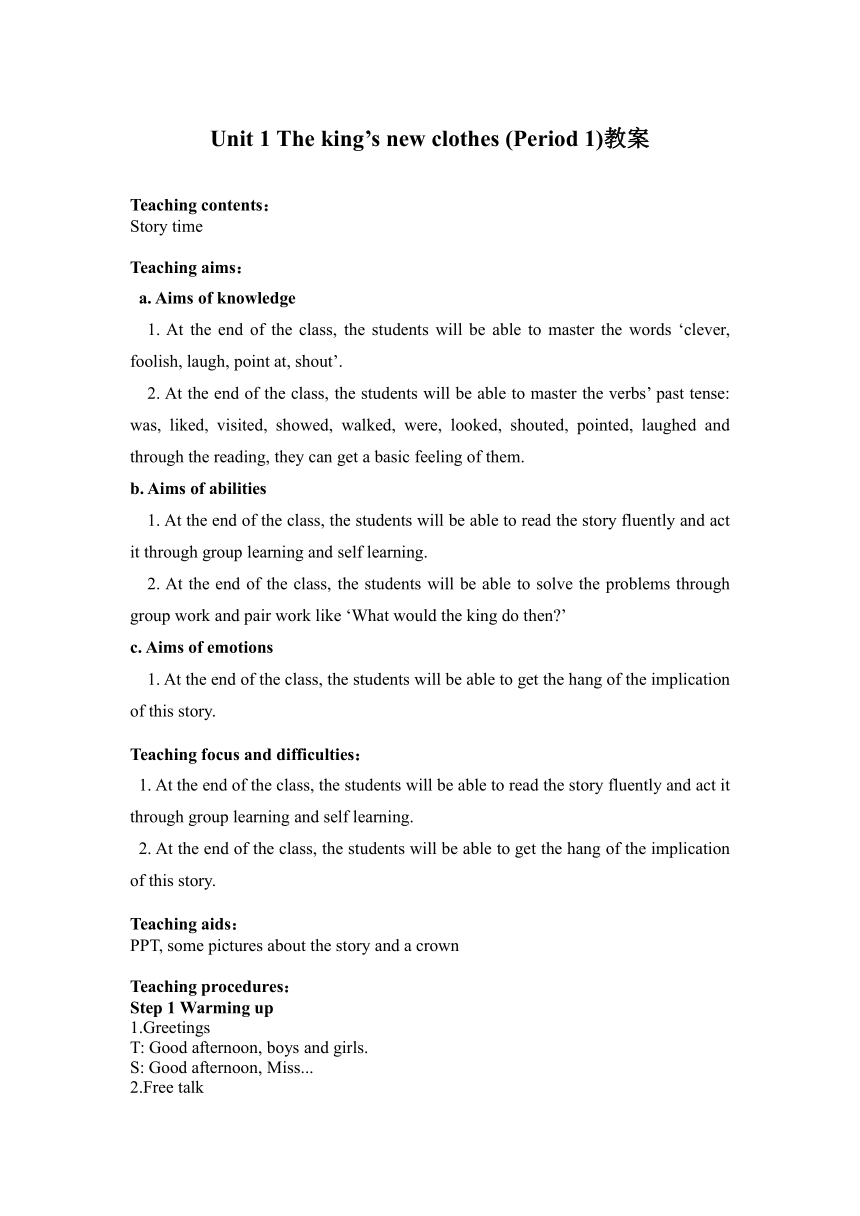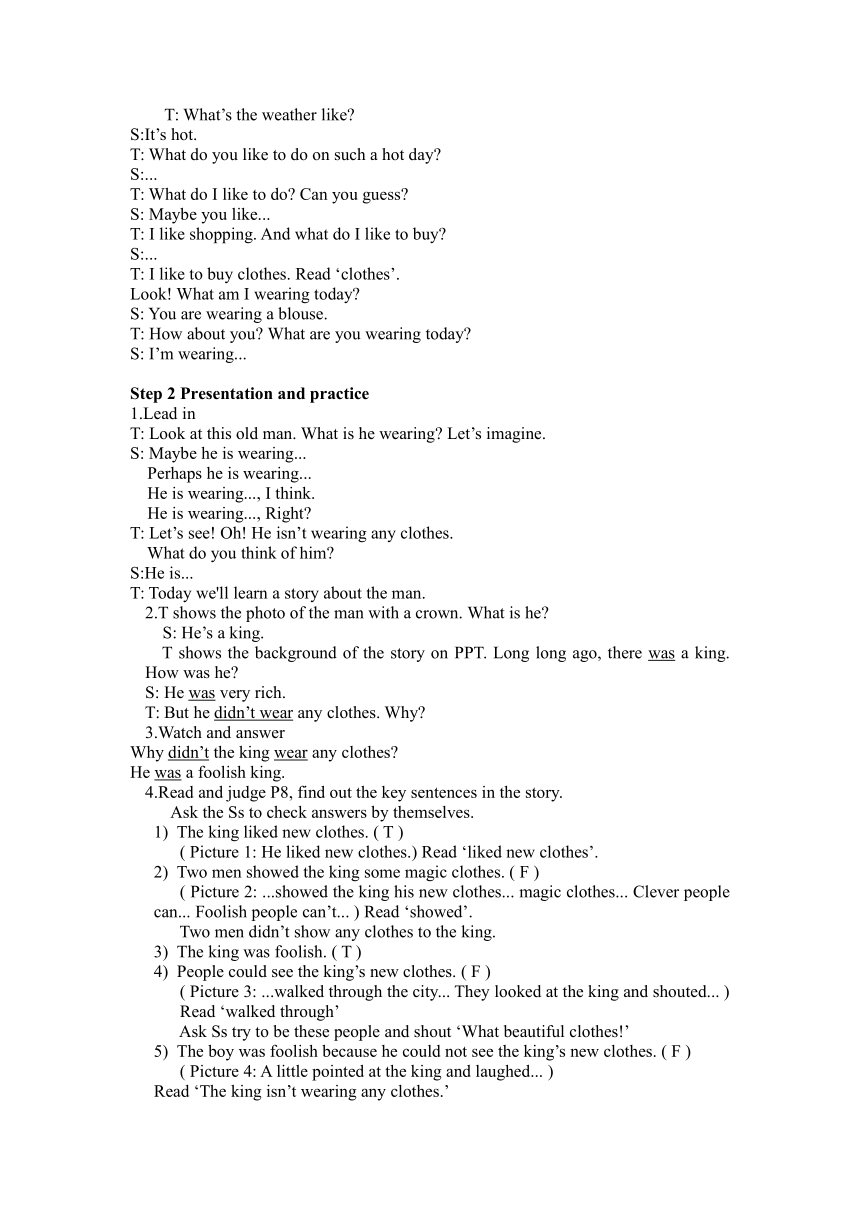Unit 1 The king’s new clothes Period 1 教案 (含反思)
文档属性
| 名称 | Unit 1 The king’s new clothes Period 1 教案 (含反思) |  | |
| 格式 | docx | ||
| 文件大小 | 100.3KB | ||
| 资源类型 | 教案 | ||
| 版本资源 | 牛津译林版 | ||
| 科目 | 英语 | ||
| 更新时间 | 2021-12-13 09:55:04 | ||
图片预览


文档简介
Unit 1 The king’s new clothes (Period 1)教案
Teaching contents:
Story time
Teaching aims:
a. Aims of knowledge
1. At the end of the class, the students will be able to master the words ‘clever, foolish, laugh, point at, shout’.
2. At the end of the class, the students will be able to master the verbs’ past tense: was, liked, visited, showed, walked, were, looked, shouted, pointed, laughed and through the reading, they can get a basic feeling of them.
b. Aims of abilities
1. At the end of the class, the students will be able to read the story fluently and act it through group learning and self learning.
2. At the end of the class, the students will be able to solve the problems through group work and pair work like ‘What would the king do then ’
c. Aims of emotions
1. At the end of the class, the students will be able to get the hang of the implication of this story.
Teaching focus and difficulties:
1. At the end of the class, the students will be able to read the story fluently and act it through group learning and self learning.
2. At the end of the class, the students will be able to get the hang of the implication of this story.
Teaching aids:
PPT, some pictures about the story and a crown
Teaching procedures:
Step 1 Warming up
1.Greetings
T: Good afternoon, boys and girls.
S: Good afternoon, Miss...
2.Free talk
T: What’s the weather like
S:It’s hot.
T: What do you like to do on such a hot day
S:...
T: What do I like to do Can you guess
S: Maybe you like...
T: I like shopping. And what do I like to buy
S:...
T: I like to buy clothes. Read ‘clothes’.
Look! What am I wearing today
S: You are wearing a blouse.
T: How about you What are you wearing today
S: I’m wearing...
Step 2 Presentation and practice
1.Lead in
T: Look at this old man. What is he wearing Let’s imagine.
S: Maybe he is wearing...
Perhaps he is wearing...
He is wearing..., I think.
He is wearing..., Right
T: Let’s see! Oh! He isn’t wearing any clothes.
What do you think of him
S:He is...
T: Today we'll learn a story about the man.
2.T shows the photo of the man with a crown. What is he
S: He’s a king.
T shows the background of the story on PPT. Long long ago, there was a king. How was he
S: He was very rich.
T: But he didn’t wear any clothes. Why
3.Watch and answer
Why didn’t the king wear any clothes
He was a foolish king.
4.Read and judge P8, find out the key sentences in the story.
Ask the Ss to check answers by themselves.
The king liked new clothes. ( T )
( Picture 1: He liked new clothes.) Read ‘liked new clothes’.
Two men showed the king some magic clothes. ( F )
( Picture 2: ...showed the king his new clothes... magic clothes... Clever people can... Foolish people can’t... ) Read ‘showed’.
Two men didn’t show any clothes to the king.
The king was foolish. ( T )
People could see the king’s new clothes. ( F )
( Picture 3: ...walked through the city... They looked at the king and shouted... )
Read ‘walked through’
Ask Ss try to be these people and shout ‘What beautiful clothes!’
The boy was foolish because he could not see the king’s new clothes. ( F )
( Picture 4: A little pointed at the king and laughed... )
Read ‘The king isn’t wearing any clothes.’
Ask Ss try to be the little boy and imitate.
5.Talk about the boy
T: What do you think of the boy
S: He is honest / ...
Read ‘honest’.
6.Read the story after the tape. Pay attention to the pronunciation.
liked /t/ visited /id/ showed /d/ walked /t/ looked /t/
shouted /id/ pointed /id/ laughed /t/
7.Read together
Step 3 Consolidation
1.Read the story again in groups and retell it.
2.Let’s make the story into a play in groups. Then act it out.
Each group can get a piece of paper. Ss need to discuss and finish the play on the paper first. Then, One student should be the narrator, other Ss act the other roles. Ss can also add up sth and make their own plays.
3.Let’s think.
T: Is it the end of the story
S: No.
T: Everyone laughed at the king. How did he feel
S: He felt ...
T gives the answer. He felt awkward.
T: What would he do
S:... ( put on his clothes, run away, kill the two men, reward the boy )
The king was foolish at first, and at last he became clever.
The boy was honest.
Honest VS Clever
Which is more important
Be honest rather than clever.
4.Who is the best actor or actress
Congratulations!
Homework:
1.Read the story with emotion, try to imitate the pronunciation and intonation.
2.Imagine and continue writing the story.
Blackboard design:
Unit 1 The king’s new clothes
Reflection after class:
本课时为故事教学,学生们对于故事内容并不陌生。在课堂初始阶段,我通过自然的询问天气,过渡到在热的天气喜欢做什么事情,引出喜欢购物,买衣服,接着和学生们讨论今天的穿着等,再以The king isn't wearing any clothes导入主题。在教学过程中,我先提出Why didn't the king wear any clothes 让学生们通过观看卡通回答,并对故事内容产生整体性的认识。在观看的过程中,学生们对故事也产生了浓厚的兴趣。在逐步理解故事的过程中,我都让学生们带着一定的任务去读,即通过对句子的判断,细化故事,具有一定的目的性,并让孩子们在文中画出相应的依据,培养学生勾画、做批注的习惯,我也注意提醒他们对于过去式的朗读要点。同时,我很注意培养学生模仿故事中人物的特点进行角色体验的活动。在教学过程中,我还重在培养学生的自主思维,比如我提出了What do you think of the king What do you think of the little boy What would the king do 等开放性问题,加深学生们对于故事的理解和思考。通过教后的复述课文和剧本再创造,能够看出学生们完成得不错,也体现了他们总结归纳的能力和综合使用语言表达的能力。英语的学习,主要在于习得、积淀语感,从而形成理解和运用语言文字的能力。在这个过程中,随着学生之间不同程度的交往和互相配合,互相帮助,以及与他人的交往能力、合作能力、平等意识都会悄无声息地增强。在英语课程中,应努力倡导学生的积极参与,让学生在学习的过程中不仅能够建构知识、提高语言能力,而且通过感知、体验、实践、参与和合作探究等活动方式,完成任务和实现目标。
Teaching contents:
Story time
Teaching aims:
a. Aims of knowledge
1. At the end of the class, the students will be able to master the words ‘clever, foolish, laugh, point at, shout’.
2. At the end of the class, the students will be able to master the verbs’ past tense: was, liked, visited, showed, walked, were, looked, shouted, pointed, laughed and through the reading, they can get a basic feeling of them.
b. Aims of abilities
1. At the end of the class, the students will be able to read the story fluently and act it through group learning and self learning.
2. At the end of the class, the students will be able to solve the problems through group work and pair work like ‘What would the king do then ’
c. Aims of emotions
1. At the end of the class, the students will be able to get the hang of the implication of this story.
Teaching focus and difficulties:
1. At the end of the class, the students will be able to read the story fluently and act it through group learning and self learning.
2. At the end of the class, the students will be able to get the hang of the implication of this story.
Teaching aids:
PPT, some pictures about the story and a crown
Teaching procedures:
Step 1 Warming up
1.Greetings
T: Good afternoon, boys and girls.
S: Good afternoon, Miss...
2.Free talk
T: What’s the weather like
S:It’s hot.
T: What do you like to do on such a hot day
S:...
T: What do I like to do Can you guess
S: Maybe you like...
T: I like shopping. And what do I like to buy
S:...
T: I like to buy clothes. Read ‘clothes’.
Look! What am I wearing today
S: You are wearing a blouse.
T: How about you What are you wearing today
S: I’m wearing...
Step 2 Presentation and practice
1.Lead in
T: Look at this old man. What is he wearing Let’s imagine.
S: Maybe he is wearing...
Perhaps he is wearing...
He is wearing..., I think.
He is wearing..., Right
T: Let’s see! Oh! He isn’t wearing any clothes.
What do you think of him
S:He is...
T: Today we'll learn a story about the man.
2.T shows the photo of the man with a crown. What is he
S: He’s a king.
T shows the background of the story on PPT. Long long ago, there was a king. How was he
S: He was very rich.
T: But he didn’t wear any clothes. Why
3.Watch and answer
Why didn’t the king wear any clothes
He was a foolish king.
4.Read and judge P8, find out the key sentences in the story.
Ask the Ss to check answers by themselves.
The king liked new clothes. ( T )
( Picture 1: He liked new clothes.) Read ‘liked new clothes’.
Two men showed the king some magic clothes. ( F )
( Picture 2: ...showed the king his new clothes... magic clothes... Clever people can... Foolish people can’t... ) Read ‘showed’.
Two men didn’t show any clothes to the king.
The king was foolish. ( T )
People could see the king’s new clothes. ( F )
( Picture 3: ...walked through the city... They looked at the king and shouted... )
Read ‘walked through’
Ask Ss try to be these people and shout ‘What beautiful clothes!’
The boy was foolish because he could not see the king’s new clothes. ( F )
( Picture 4: A little pointed at the king and laughed... )
Read ‘The king isn’t wearing any clothes.’
Ask Ss try to be the little boy and imitate.
5.Talk about the boy
T: What do you think of the boy
S: He is honest / ...
Read ‘honest’.
6.Read the story after the tape. Pay attention to the pronunciation.
liked /t/ visited /id/ showed /d/ walked /t/ looked /t/
shouted /id/ pointed /id/ laughed /t/
7.Read together
Step 3 Consolidation
1.Read the story again in groups and retell it.
2.Let’s make the story into a play in groups. Then act it out.
Each group can get a piece of paper. Ss need to discuss and finish the play on the paper first. Then, One student should be the narrator, other Ss act the other roles. Ss can also add up sth and make their own plays.
3.Let’s think.
T: Is it the end of the story
S: No.
T: Everyone laughed at the king. How did he feel
S: He felt ...
T gives the answer. He felt awkward.
T: What would he do
S:... ( put on his clothes, run away, kill the two men, reward the boy )
The king was foolish at first, and at last he became clever.
The boy was honest.
Honest VS Clever
Which is more important
Be honest rather than clever.
4.Who is the best actor or actress
Congratulations!
Homework:
1.Read the story with emotion, try to imitate the pronunciation and intonation.
2.Imagine and continue writing the story.
Blackboard design:
Unit 1 The king’s new clothes
Reflection after class:
本课时为故事教学,学生们对于故事内容并不陌生。在课堂初始阶段,我通过自然的询问天气,过渡到在热的天气喜欢做什么事情,引出喜欢购物,买衣服,接着和学生们讨论今天的穿着等,再以The king isn't wearing any clothes导入主题。在教学过程中,我先提出Why didn't the king wear any clothes 让学生们通过观看卡通回答,并对故事内容产生整体性的认识。在观看的过程中,学生们对故事也产生了浓厚的兴趣。在逐步理解故事的过程中,我都让学生们带着一定的任务去读,即通过对句子的判断,细化故事,具有一定的目的性,并让孩子们在文中画出相应的依据,培养学生勾画、做批注的习惯,我也注意提醒他们对于过去式的朗读要点。同时,我很注意培养学生模仿故事中人物的特点进行角色体验的活动。在教学过程中,我还重在培养学生的自主思维,比如我提出了What do you think of the king What do you think of the little boy What would the king do 等开放性问题,加深学生们对于故事的理解和思考。通过教后的复述课文和剧本再创造,能够看出学生们完成得不错,也体现了他们总结归纳的能力和综合使用语言表达的能力。英语的学习,主要在于习得、积淀语感,从而形成理解和运用语言文字的能力。在这个过程中,随着学生之间不同程度的交往和互相配合,互相帮助,以及与他人的交往能力、合作能力、平等意识都会悄无声息地增强。在英语课程中,应努力倡导学生的积极参与,让学生在学习的过程中不仅能够建构知识、提高语言能力,而且通过感知、体验、实践、参与和合作探究等活动方式,完成任务和实现目标。
